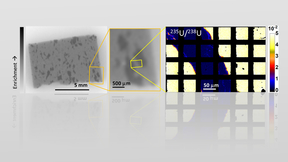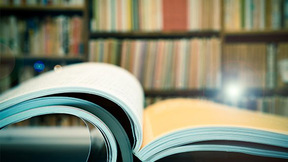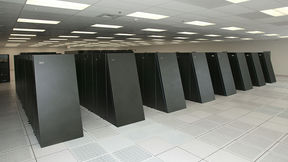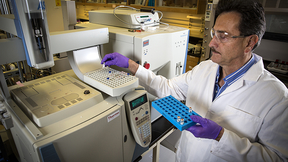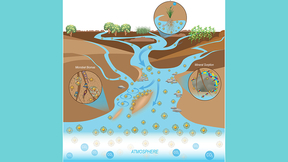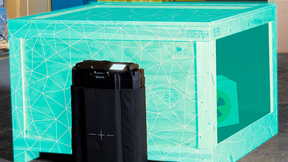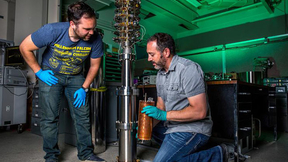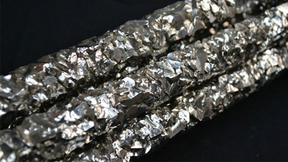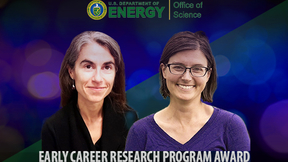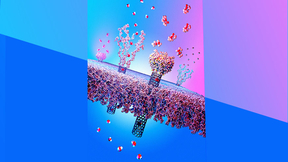Back
As the solar system was developing, the giant planets (Jupiter and Saturn) formed very early, and as they grew, they migrated both closer to and further away from the sun to stay in gravitationally stable orbits. The gravitational effect of these massive objects caused immense reshuffling of other planetary bodies that were forming at the time, meaning that the current…
When it comes to the semiconductor industry, silicon has reigned as king in the electronics field, but it is coming to the end of its physical limits. To more effectively power the electrical grid, locomotives and even electric cars, Lawrence Livermore National Laboratory (LLNL) scientists are turning to diamond as an ultra-wide bandgap semiconductor. Diamond has been…
Lawrence Livermore National Laboratory (LLNL) scientists received mock evidence, consisting of two uranium oxide (UO2) fuel pellets, as part of an international nuclear forensic exercise in support of a simulated nuclear smuggling investigation. The exercise was part of the CMX-5 Collaborative Materials Exercise organized by the Nuclear Forensics International Technical…
Fifty-seven researchers from Lawrence Livermore National Laboratory (LLNL) were among the top 2 percent of the most cited researchers worldwide throughout their careers, according to research on metascience by Stanford University. Metascience is the "study of studies" using scientific methods. Stanford University professor John Loannidis worked alongside U.S.-based Kevin…
Growing up in Lima, Peru, Livermore chemist Carlos Valdez excelled in art and soccer. But his first love was science.
A team of current and former Lawrence Livermore National Laboratory (LLNL) and IBM scientists won the annual “Test of Time” award at the 2020 Supercomputing Conference on Nov. 19 for a paper outlining LLNL’s Blue Gene/L supercomputer. Published by the Supercomputing Conference in 2002, the paper was the first peer-reviewed overview article to disclose details of Blue Gene…
The Forensic Science Center is an important ally in the international endeavor to prohibit chemical warfare agents.
A long time ago — roughly 4.5 billion years — our sun and solar system formed over the short time span of 200,000 years. That is the conclusion of a group of Lawrence Livermore National Laboratory (LLNL) scientists after looking at isotopes of the element molybdenum found on meteorites. The material that makes up the sun and the rest of the solar system came from the…
Like water molecules in a river, soil carbon atoms are always in motion. To better understand this action, Lawrence Livermore National Laboratory (LLNL) scientists and collaborators have created a new conceptual framework as well as a simulation model that traces the path of individual carbon atoms as they interact with the environment -- undergoing biochemical…
Identifying the areas where paleowater or “fossil water” — water that recharged before the Holocene started 12,000 years ago — is pumped for drinking water supply helps managers decide whether groundwater can sustainably meet future demands. This type of groundwater recharged during rainy periods under cooler and wetter conditions that ended about 10,000 years ago. Since…
In another month-and-a-half, a score of chemists from Lawrence Livermore National Laboratory's Forensic Science Center (FSC) will start two weeks of long days to undertake the Organization for the Prohibition of Chemical Weapons (OPCW) environmental proficiency test. Livermore chemists have been taking the proficiency tests each October since 2001, with LLNL serving as one…
In addition to maintaining its Organization for the Prohibition of Chemical Weapons (OPCW) laboratory designation for analyzing suspect environmental samples, LLNL also is an OPCW-designated laboratory for the analysis of biomedical samples. (See "Lab earns 'A' in OPCW test) In this instance, OPCW inspectors have the ability to collect biomedical samples for cases of…
Livermore physicist Sean Walston is a co-developer for the MC-15 portable neutron multiplicity detector.
Lawrence Livermore researchers and collaborators are searching for the axion—a low-mass particle that could make up the majority of dark matter.
Livermore scientists, in collaboration with university partners, are studying ways to harvest rare isotopes, including a radioactive isotope of the element zirconium.
Lawrence Livermore National Laboratory (LLNL) researchers, in collaboration with Pennsylvania State University (PSU) and Idaho National Laboratory (INL), have designed a new process, based on a naturally occurring protein, that could extract and purify rare earth elements (REE) from low-grade sources. It could offer a new avenue toward a more diversified and sustainable…
Two scientists from Lawrence Livermore National Laboratory (LLNL) are recipients of the Department of Energy’s (DOE) Office of Science Early Career Research Program award. Federica Coppari and Erin Nuccio are among 76 scientists nationwide selected for the recognition. Under the program, typical awards for DOE national laboratory staff are $500,000 per year for five years…
Recent events such as the COVID-19 pandemic and the use of chemical weapons in the Syria conflict have provided a stark reminder of the plethora of chemical and biological threats that soldiers, medical personnel and first responders face during routine and emergency operations. Personnel safety relies on protective equipment which, unfortunately, still leaves much to be…
The predictive models that describe the fate and transport of radioactive materials in the atmosphere following a nuclear incident (explosion or reactor accident) assume that uranium-bearing particulates would attain chemical equilibrium during vapor condensation. In a new study, funded by the Office of Defense Nuclear Nonproliferation Research and Development (DNN R&D…
A tiny, invisible particle could offer help for a big problem — the threat of nuclear proliferation. For more than six decades, scientists have been developing instruments for fundamental physics that can detect antineutrinos, particles that have no electric charge, almost no mass and easily pass through matter. Antineutrinos are emitted in vast quantities by nuclear…



